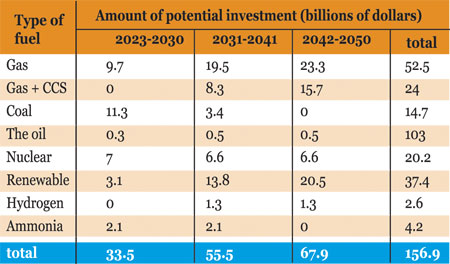$157 b master plan to be implemented in 28-yrs
Luxury investment plans
Mahfuz Emran: At present, the power generation capacity in the country is 23 thousand 482 MW. The target of increasing it to 111,138 MW in 2050 has been set in the draft of the proposed ‘Integrated Energy and Power Master Plan (IEPMP) 2023’. That is, production capacity will be increased by about 373 percent in 28 years. For the implementation of this luxurious master plan, about $157 billion will have to be spent on the construction of the power plant alone.
According to the master plan, the country’s power generation capacity will be 38,895 megawatts in 2030. In other words, the capacity should be increased to 15,413 MW in eight years. $33.5 billion will be invested to build this additional capacity. Of this, gas-fired power plants will cost $9.7 billion, coal-fired plants $11.3 billion, nuclear power plants $7 billion, renewable energy plants $3.1 billion, and oil-fired plants $0.3 billion. Besides, $2.1 billion will be invested for ammonia-based power plant. Although this power plant will come into production after 2030.
Similarly, in 2041, the power generation capacity in the country will stand at 74,253 megawatts. That is, the capacity should be increased to 35 thousand 358 MW in the next 11 years. $55.5 billion will be invested to build this additional capacity. Of this, $19.5 billion will be spent on gas-fired power plants, $3.4 billion on coal plants, $6.6 billion on nuclear power plants, $13.8 billion on renewable energy plants, and $0.5 billion on oil-fired plants. Apart from this, two and a half billion dollars have to be invested for the ammonia-based power plant and one and three billion dollars have to be invested for the hydrogen-powered power plant. In addition, carbon capture storage (CCS) technology power plants will require investment of $8.3 billion.
Meanwhile, by the year 2050 i.e. in the last 9 years, the power generation capacity in the country should be increased to 36,885 megawatts. $67.9 billion will be invested to build this additional capacity. Of this, $23.3 billion will be spent on gas-fired power plants, $6.6 billion on nuclear power plants, $20.5 billion on renewable energy plants, and $0.5 billion on oil-fired plants. Besides, for hydrogen-powered power plants, an investment of 1.3 billion dollars will be required and for CCS technology power plants, an investment of $15.7 billion will be required.
However, where this huge investment will come from is not mentioned in the master plan. Besides, experts consider such luxury investment plan to be a burden for the country. When asked, Hasan Mehedi, member secretary of the Bangladesh Alliance for Environment and Development Affairs (BWGED), told Daily Industry that if renewable energy is given importance, the amount of investment will decrease a lot. Because the cost of building a coal-based power plant per kilowatt is currently $1,480 on average. However, the average cost of building a solar power plant per kilowatt is $623. That is, about two and a half times the investment cost is required.
He also said that it is possible to use natural energy in solar or wind power. But there will be additional cost to ensure fuel supply to other power plants. Besides, there is no capacity charge on renewable electricity. Hence, emphasis should be placed on renewable electricity to reduce unnecessary expenditure and investment demand.
It should be noted that in addition to the construction of power plants, it is said in the master plan that another $180 billion will be invested in the construction of various types of infrastructure to supply the necessary energy to them.
Rare Israeli airstrike in Beirut kills Hezbollah commander and more than a dozen others
International Desk: Israel launched a rare airstrike that killed a senior Hezbollah milita…








